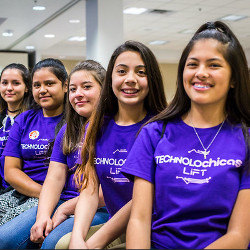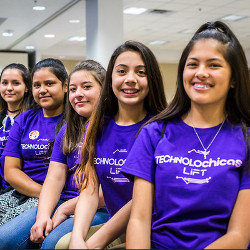
Achieving diversity in computing is a pressing national concern in the U.S.8,14 Computing-related jobs will be among the fastest growing and highest-paying over the next decade according to the U.S. Bureau of Labor Statistics.16 Yet, women are significantly underrepresented in computing degrees and careers, holding only 26% of U.S. computing occupations.17 There is even a greater dearth of women of color in computing, especially Latinas. Eighteen percent of the U.S. population is Hispanic and Latinx, yet currently only 1% of the jobs in the computing workforce are occupied by Latinas. Latinx girls represented a mere 4% of all students taking the AP computer science exam in 2017.11 In 2014, Hispanic women received only 2% percent of doctoral degrees in computer and information sciences.
The National Center for Women & Information Technology (NCWIT; see https://www.ncwit.org) was chartered in 2004 to broaden the participation of women and girls across the technology ecosystem (K–12, higher education, and industry). NCWIT's organizational mission is centered around the concept of intersectionality: equity efforts must take into consideration how race, class, gender, and other aspects of identity shape strategies and approaches to broadening participation in computing.6 Research supports that such approaches are a key component in ensuring the full access, engagement, and inclusion of women and girls of color in STEM and computing.1,2,9,14
TECHNOLOchicas provides various types of resources, in English and Spanish, to help families encourage the young women in their lives to pursue computing.
Employing an intersectional framework is critical in understanding how to address the underrepresentation of Latinas in computing. Latina girls and women in the U.S. are avid users of technology, but they are significantly underrepresented in its creation. There are several unique barriers facing Latinas' participation in computer science, including: a lack of access to CS classes in school and afterschool programs;4 lower levels of STEM and CS confidence and self-efficacy;18 a lack of family support and encouragement to pursue computing careers;3 and a lack of Latina role models in computer science.5,8,10,15
In January 2015, NCWIT and Google convened a historic roundtable session in Washington, D.C., to address the challenge of how to increase Latinas' awareness, interest, and involvement in technology. Dozens of stakeholders from various sectors—including government, industry, and non-profit change leaders—participated in the 2015 meeting. Attendees spent the day identifying ways to broaden the participation of Latinas in tech, and developing key strategies to support and encourage young Latinas. Participants agreed on the value of creating a media campaign to redefine the mainstream image of computer science and information technology to make it more inclusive and appealing to young Latinas. In partnership with the Televisa Foundation,a TECHNOLOchicas was born (see https://technolochicas.org/).
Guided by the distinctive voices and perspectives of Latinas, TECHNOLOchicas was designed as a national initiative attentive to the unique barriers facing Latinas in gaining access and inclusion in computing, and to inspire the next generation of Latina technology innovators. Visibility is a key aspect of the initiative, as we understand that young Latinas "can't be what they can't see." The first TECHNOLOchicas public service announcement (PSA) debuted on January 18, 2016, bringing positive Latina role models into the homes of millions. The program celebrates and highlights Latinas achieving success in tech who inspire young women to pursue computing. The campaign helps to show the Latinx community that their daughters can achieve the same, or even greater, success in the technology industry.
TECHNOLOchicas provides various types of resources, in English and Spanish, to help families encourage the young women in their lives to pursue computing. These materials include research-based guides and tips, inspirational videos, and profiles of real-life Latina role models. An example is "Top 10 Ways Families Can Encourage Girls' Interest in Computing,"b which offers tips for sparking interests and taking advantage of hands-on learning opportunities as just a couple of key ways for families to help further the TECHNOLOchicas mission of increasing the meaningful participation of Latinas in the tech industry. Connecting a girl's current interests to computing concepts and discussing how computing is relevant in improving everyday social issues is also critical. Online videos and profiles of more than 300 TECHNOLOchicas help girls see real-life, diverse Latinas in tech. These stories also help young girls understand how they can connect their own interests into the development of cutting-edge products and solutions for society at large.
Measuring Impact
"In the four years since the launch of TECHNOLOchicas, important strides have been made in raising awareness through our simple message of, 'I'm Latina and I love technology.'" TECHNOLOchicas PSAs have aired more than 10,000 times in more than 20 Univision markets across the country reaching millions of Spanish-speaking households. There are more than 320 TECHNOLOchicas Ambassadors throughout the United States and Puerto Rico, a network of college-aged Latinas who serve as near-peer role models to the younger students and facilitate hands-on computing workshops, provide guidance and practical advice on how to gain access to pathways into computing, and inspire girls to become the future of the tech workforce.
TECHNOLOchicas has held more than 500 outreach events nationwide, where more than 5,000 Latinas have learned directly from their peer role models. For many, these events have been their first exposure to computing, and for others it has served as encouragement to pursue a path in computing. Providing exposure to computing fields through a shared cultural lens helps students create a computing identity at a young age and helps them persist. It is also important for Latinas pursuing computing degrees to have access to mentorship and role models that share a common cultural background. TECHNOLOchicas Ambassadors hold events around the country to expose girls to coding and other aspects of computing careers. Events are evaluated qualitatively. Participants report that they benefit in various ways from exposure to Latina professionals, including:
- "… learning more about Latina women in the STEM Field and how they got to where they are today."
- "…listening to the different backgrounds of the TECHNOLOchicas that led to where they are now"
- "…being around so many ambitious Latinas."
- "..listening to the different backgrounds of the TECHNOLOchicas that led to where they are now."
The ambassadors themselves are also positively impacted by their experiences in the TECHNOLOchicas program. The following quotes exemplify the types of impact reported:
- "TECHNOLOchicas is an inspiring and powerful community to be a part of. I'm not only surrounded by incredible leaders in STEM, but I'm also collaborating with them to inspire and shape the next generation of Latina Engineers."
- TECHNOLOchicas motivates me to continue to be the best engineer I can possibly be while helping others become the best version of themselves as well.
At its core, TECHNOLOchicas seeks to inspire Hispanic girls and their families. Collected qualitative data suggests this effect is being realized. After attending an outreach event, girls report being inspired. Asked what they plan to do after attending their local event, responses include persisting in the face of challenges, focusing on doing well in school, and sticking with computing or engineering because they can see now where it will get them. Representative excerpts include:
As a result of attending today's event, I plan to…
- Learn and teach others about computing;
- Continuing to work hard in my engineering class;
- Work even harder because my opportunities are endless.
Since TECHNOLOchicas began, there has been a promising trend upward in the percentage of Latinas taking the AP Computer Science Principles (CSP) exam. As The College Board (2019) notes, the CSP exam was designed to invite a more diverse group of students to technology. In 2017, 2,642 Latinas took the exam, reflecting six percent of all test takers. By 2019, 6,393 Latinas sat for the test, and represented 6.7% of the testing population. While there is no direct linkage between TECHNOLOchicas and the number of Latinas taking the CSP exam, it nonetheless encouraging that Latinas are receiving support and encouragement to consider educational and career pathways in technology.
Shaping the Color of Our Future
NCWIT, as well as other change leaders working to advance the Latinx community, including Latinas in STEM,c Hispanic Heritage Foundation,d and the Eva Longoria Foundation,e can change the trajectory and economic prospects of Latinx families in the U.S., who can help fill the anticipated 3.5 million computing-related job openings by 2026.6 By being part of this change, we hope that future generations of Latinas will face fewer barriers to pursuing careers in computing. As women of color in this space, it is both rewarding and fills us with great pride to know that we are uplifting entire communities, and an entire nation.
The TECHNOLOchicas initiative has helped us see we have the potential to influence the participation of women and girls of color from other under-represented backgrounds (including Black and Native American) in computing. We need more national programs and initiatives that employ an intersectional approach to address the shortage of Latinas and other girls of color in tech. Recently, NCWIT spearheaded The Color of Our Future initiative, which anchors NCWIT programs, initiatives, and research-based resources focused on broadening the meaningful participation of underrepresented women and girls of color to positively impact the future of computing.
Yet in order to shape the future of tech, we need both intersectional and mainstream approaches to equity and representation. The presence of targeted, intersectional programs should not erase the need for more inclusive programs targeted at broadening the participation of women and other underrepresented populations across the tech ecosystem. Computing programs and the overall tech industry should be intentional and holistic in their approaches and aim to be as intersectional and inclusive as possible.
TECHNOLOchicas has empowered many Latinas in tech, giving them a sense of belonging and confidence they often lacked. Helping Latinas of all ages see the potential they have to influence the technologies that are created in the future will be game-changing for this industry.




Join the Discussion (0)
Become a Member or Sign In to Post a Comment